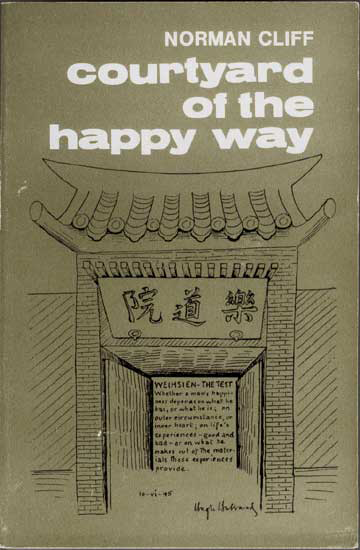
- by Norman Cliff
Chapter 11
[excerpts] ...[...]
 One snowy day in January 1945, when I was working in greasy overalls over a kua (cauldron) in Kitchen 1, a tall American nicknamed Skipper came running in and said, “Have a look at what’s coming in at the front gate!”
One snowy day in January 1945, when I was working in greasy overalls over a kua (cauldron) in Kitchen 1, a tall American nicknamed Skipper came running in and said, “Have a look at what’s coming in at the front gate!”
A moment later we were standing on Main Road, witnessing an unbelievable sight. Donkeys and carts were filing in slowly up the hill towards the church (the usual venue for such emergencies). Fifteen hundred boxes marked “American Red Cross” were unloaded.
There were 1500 internees in Weihsien Camp one big box each! There was wild excitement at the prospect of having some good nutritious food and the possibility of enjoying delicacies we had not tasted for years. Since our arrival in “Courtyard of the Happy Way” we had not tasted fruit, milk, sugar or butter.
But most excitement and surprises in this war period seemed inevitably to have their anticlimaxes, and this was no exception. Soon afterwards a notice appeared on the camp notice boards announcing curtly that the distribution of parcels had been cancelled, as consideration was being given as to whether the donors intended them to go solely to the two hundred Americans in Weihsien.
Two weeks of arguing and dissension among the American community followed, the majority of them being adamant that the boxes should be shared with all. A few families, in spite of their missionary status, spoke loudly about the “morality” of ensuring that the parcels were given to those for whom they were intended.
Meanwhile the local Japanese authorities, perplexed at civilised Westerners haggling in this manner, consulted their headquarters for instructions on how to distribute the boxes. The decision from Tokyo was a wise and equitable one. One parcel for every internee.
Soon a fresh date was fixed for the distribution of the parcels. We queued up at the church and then each struggled to his digs with a heavy cardboard box, three feet by one foot by one-and-a-half feet. Sitting at our beds, we eagerly ripped the boxes open. In each were four small sections, each with powdered milk, cigarettes, tinned butter, spam, cheese, concentrated chocolate, sugar, coffee, jam, salmon and raisins.
Tea could now be drunk with milk and sugar. Bread, our staple, diet, could now be eaten with butter and cheese or jam. Cigarettes could be traded with smokers for further items of food. The long list of items lent themselves to all kinds of recipes and combinations.
If these welcome supplies were used to supplement the official camp rations from the kitchen, and used in careful instalments, we could enjoy nutritious and tasty meals for at least four months to come.
[further reading] ...
http://www.weihsien-paintings.org/NormanCliff/Books/Courtyard/eDocPrintPro-BOOK-Courtyard-01-WEB-(pages).pdf
#








